DEVELOPMENT OF NEW DIAGNOSTIC EQUIPMENT FOR MEDICINE
Optical noninvasine reflectance tissue oximeter "Spectrotest":
This optical noninvasive reflectance tissue oximeter "Spectrotest", created together with Closed-End Company Association "Istok-EOS" and State Scientific and Production Company "Ciklon-Test", is intended for in vivo functional examination of the system of blood microcirculation, as well as of the oxygen transport in a patient's skin in real time. The principle of functioning of the device is based on the use of methods of absorbing spectroscopy for the light-scattering media allowing indirectly through an estimation of optical and physical properties of these media to obtain information on maintenance in a zone of inspection of various biochemical components, allowing to identify these substances among other components in the media using their specific absorption spectra. For the reception of the diagnostic information using the device "Spectrotest", the examined tissue is illuminated by low-intensity optical radiation of visible and near infrared range of wavelengths, and the special photodetector of an optical probe registers the backscattered radiation. During calculations, based on the registered optical density of skin in different spectral wavebands, the contribution to a useful optical signal from blood in the tissue is estimated. The general depth of scanning of tissues for different types of them is an order of 3-5 mm, i.e. small arteries get to an inspection zone, venules, shunts, and also a network of capillaries penetrating the tissue. For the purpose of terminology simplification, the blood content in all these links of microcirculation bed in engineering documentation on the device is conditionally named as capillary blood content.
The main measured by the oximeter parameter is:
- the index of capillary blood content in a tested volume of the soft tissue (Vb).
Additional measured parameters are:
- the index of average (per both arterial and venal parts of the blood microcirculation system) saturation of oxyhemoglobin in the peripheral mixed blood (index of hemoglobin oxigenation) in the tested volume of tissue (tissue's saturation SO2 or StO2);
- the index of a melanin content within a skin (Me).
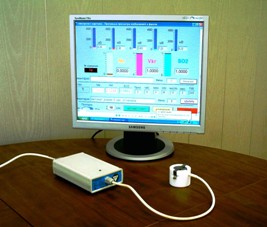
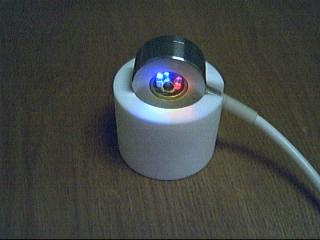
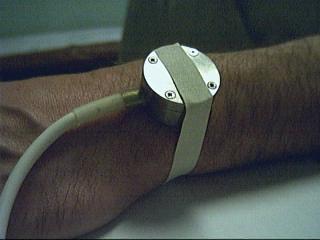
A contribution of capillary blood in a total optical signal from a biotissue generally depends on actually blood volume circulating in a volume of inspection, and on a degree of disclosing of capillaries, especially of superficial. Therefore the relative index Vb displayed by the device is the complex integrated parameter characterizing both these processes. Registration and calculation of the average StO2 is carried out on the basis of a difference in optical properties of oxygenated and reduced hemoglobin fractions. Thus, at work the device perceives the information from all specified above vascular parts of microcirculation bed, therefore the registered index of tissues saturation StO2 is also an integrated parameter characterizing average relative content of HbO2 in the system of microcirculation, averaged on all capillary and arterio-venous channels getting to a zone of inspection. However, as a venal blood on the average in the inspection volume is contained in a general case in 4-6 times more than arterial one, the parameter of tissues saturation is closer to a value of venous saturation SvO2 that allows, knowing an arterial saturation SaO2 (or at least a pulse-saturation SpO2), approximately to estimate an oxygen uptake by tissue's cells. The system of data processing of the oximeter uses a method of the analytical solution of the inverse optical problem for light-scattering media and allows right after the probe positioning on a body of the patient in real time to receive on the screen of the monitor a full diagnostic result. Unlike indirect analogues of this device – pulsoximeters – the parameters of capillary blood volume and oxygenation of peripheral blood are registered by "Spectrotest" without using the registration of blood pulse waves, i.e. any measurements in conditions of occlusion of vessels and of stagnation of blood flow are possible. Oximeter "Spectrotest" is protected by the patent of Russian Federation No. RU2234853 from 26.12.2002. It has the Federal Registration Certificate of Russian Federal Agency of Healthcare Inspection and Social Development No. FS 022a2006/3254-06 from May, 15th, 2006 as well as the Certificate of Safety of Gosstandart of the Russian Federation.
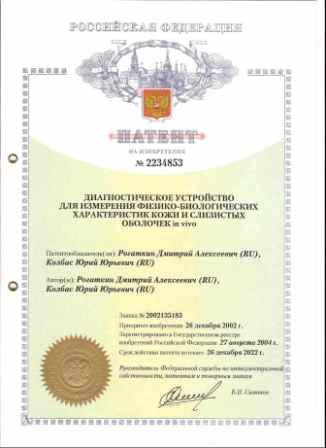
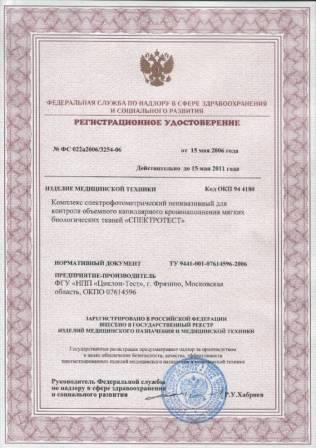
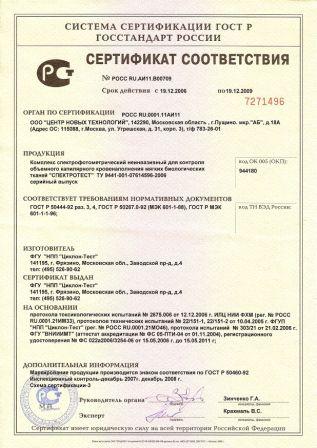
Multipurpose laser noninvasive diagnostic system "LAKK-M":
The multipurpose laser noninvasive diagnostic system (MLNDS) "LAKK-M", created together with SPE "LAZMA" Ltd., functions on a basis of a simultaneous application of methods of Laser Doppler flowmetry (LDF), laser fluorescent spectroscopy (LFS), optical pulsoximetry (OPO) and reflectance tissues oximetry (RTO). It covers today all the most perspective techniques of the modern NMS in a medical science. New technical decisions, optical fiber probe and more developed software allow directly in a doctor's office of any specialization to execute complex in vivo (in situ) functional examinations of patients directed on revealing of thin specific features of microhemodynamics, infringements of a metabolism of oxygen in the system of blood microcirculation and dynamics of relative concentration of oxidation-reduction enzymes (NADH, FAD, lipopigments, porphyrins) in a surveyed site of a biotissue. The optical probe (a fibre optical probe) of the system, used as a diagnostic probe, also is adapted for the usage through the instrumental channel of endoscopes, colonoscopes, etc. allowing a doctor to produce any endoscopic diagnostic procedures.
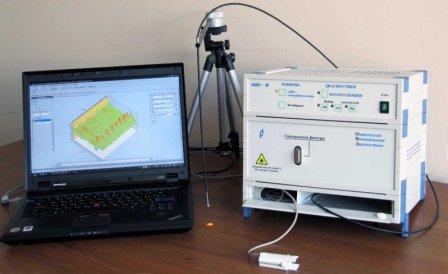
Registered and determined main medical parameters:
- index of tissue’s blood perfusion (Im) as a function of time;
- functional pulse-saturation of oxyhemoglobin in arterial blood of the system of blood microcirculation (SpO2) as a function of time;
- functional saturation of oxyhemoglobin fraction in a mixed peripheral blood of the system of blood microcirculation (StO2) as a function of time;
- relative volume of all fractions of hemoglobin (volume of blood) in a tested tissue's volume (Vb) as a function of time;
- an index of perfusional saturation of the oxygen in a blood (StO2m);
- parameter of a specific oxygen utilization in a tissue (U);
- frequency rhythms of regulation of microcirculation parameters (miogenic rhythm, neurogenic one, endothelial, etc.) at performance of the base functional test;
- functional reserves in the system of blood microcirculation and the type of blood microcirculation in tissues of the patient (normal type, hyperemic type, spastic one) at performance of loading functional tests with arterial occlusion;
- coefficients of fluorescent contrast of tissue (transcutanous indexes of content of the substances in a tissue) under excitation of fluorescence in ultraviolet (365 nm), green (532 nm) and red (635 nm) spectral wavebands, which indicate a content in the tissue and activity of different tissue’s enzymes and proteins (collagen, elastin, NADH, FAD, lipopigments, porphyrins, etc.).
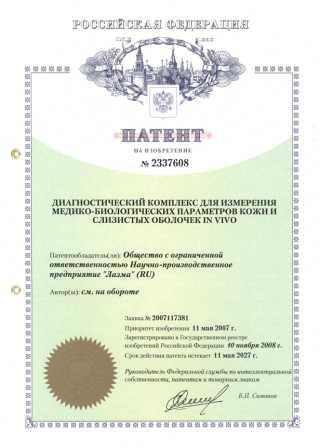
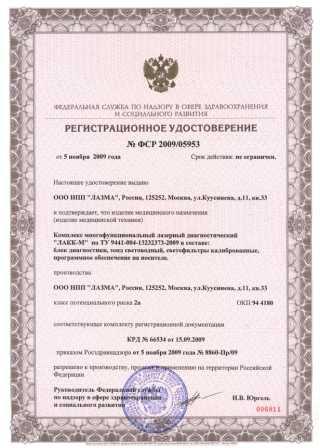
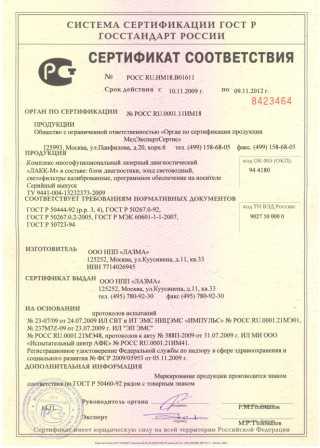
The design of the system is protected by Russian Patent No. RU2337608 and the international application form on PCT procedure: PCT/RU2008/000275, publishing No. WO/2008/140355. Holder of the patent is SPE "LAZMA" Ltd. The system has passed all official state technical and clinical trials and has got on 05.11.2009 the Federal Registration Certificate of Russian Federal Agency of Healthcare Inspection and Social Development No. FSR 2009/05953 as well as the Certificate of Safety of Gosstandart of the Russian Federation No. ROSS RU.IM18.V01611.
Main areas of application in medicine:
- Oncology and radiology: diagnostics of malignant tumors, an estimation of the oxygen status of tumors;
- Angiology: instrumental registration of blood microcirculation in tissues, an assessment of functioning of shunts and capillaries;
- Endoscopy: an estimation of stages of erosive-ulcer and tumoral processes;
- Endocrinology: an estimation of levels of trophic infringements in extremities at a diabetes;
- Professional pathology: an estimation of vascular and trophic infringements at vibrating illness (white finger syndrome) and bronho-pulmonary pathologies;
- Surgery: a choice of a place of a fence (formation) of a transplant, definition of degree of its viability;
- Surgery: determination of type of a tissue at microsurgery operations with stem cells.
Multifunctional laser diagnostic system "Multicom":
The multifunctional laser non-invasive diagnostic system "Multicom" was created in 2015 jointly with the Research and Development Center "EOS-MEDICA" LLC. It is the more multifunctional and modern modification of the "LAKK" series of complexes. A channel for backscattering spectroscopy in white light has been added to the Multicom system, the spectral range has been expanded to 270-950 nm, optical fibers have been modified, which now make it possible to create a uniformly illuminated diagnostic volume of biological tissue, and the optical filter unit in front of the spectrometer is made with the ability to smoothly adjust the optical density each filter for pre-diagnostic signal calibration and creating conditions for a single metrological adjustment of a series of similar devices. The structure of the complex is protected by the patent RF № 2657294 from 15.12.2016.
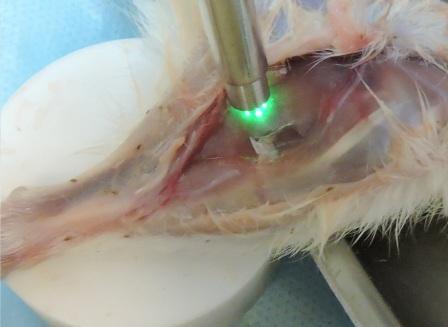

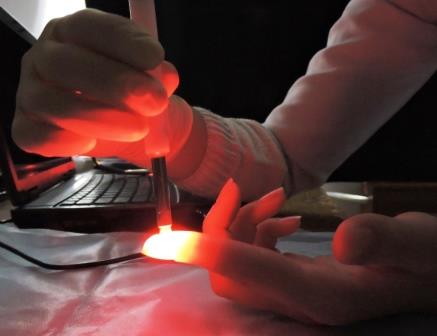
Main determined and calculated biomedical parameters:
As with the LAKK-M systems, first of all, with the help of the Multicom system, the coefficients of fluorescent contrast in biological tissues (transcutaneous indices of the substance tissue content) are determined upon excitation of fluorescence in ultraviolet (365 nm), green (532 nm) and red (635 nm) wavelength ranges characterizing the relative levels of accumulation in tissues of various proteins and redox enzymes of tissue cells (collagen, elastin, NADH, flavines, lipopigments, porfirins, etc.). Backscattering spectroscopy using white light from 270 nm to 950 nm range makes it possible to calculate the coefficients of light absorption by tissues in this spectral wavelength range, determine the blood content of tissues, and normalize the fluorescence signal (indices of tissue content of a substance) to the blood content according to the algorithms of Ph.D. Irina Raznitsyna

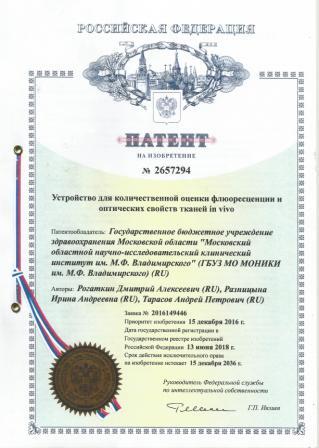

Main areas of application in medicine:
The fields of application of this system generally correspond to the fields of application in medicine of the systems of "LAKK" series. One of the main applications is oncology. The system was developed to predict the radio- and chemosensitivity of tumors during chemoradiotherapy. However, in connection with the additional channel of white light, two new areas of its application are opening up - surgery and dermatology.
- Oncology and radiology: prognosis of radio- and chemosensitivity of tumors in chemoradiotherapy;
- Dermatology: evaluation and prognosis of the minimum erythema dose in UV treatment of skin diseases;
- Surgery: verification of tissue type during surgery and stem cell injections.
Tonometer-based device with the function of vessels functioning assessment:
Tonometer with extended functions (prototype) was created in 2017-2019 jointly with LLC "Research and Development Center "EOS-MEDICA"", LLC "ODS-MED" and JSC "Elatomsk Instrument Plant". This BP monitor is designed to implement a comprehensive non-invasive diagnostic technology "Vasotest", allowing simultaneously with the measurement of blood pressure for a time of about 8-10 minutes to conduct an express assessment of the main parameters of central and peripheral hemodynamics. The design of the device is protected by a series of patents of the Russian Federation. Measurements are carried out completely automatically. The left and right sides of the body are examined simultaneously.
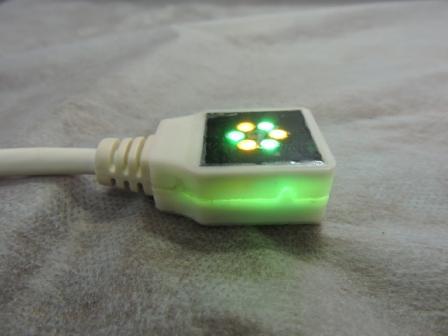
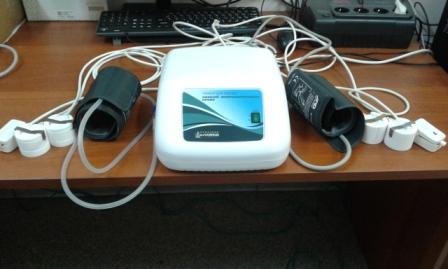
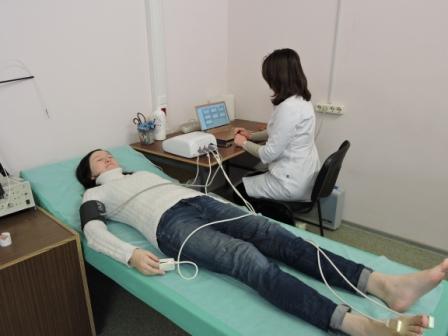
Main measured and computed biomedical parameters:
- Systolic, diastolic, average and pulse blood pressure (SBP, DBP, ABP, PBP);
- Pulse rate (PR);
- Peripheral vascular resistance (PVR);
- Pulse wave velocity in aorta, as well as at the intervals "shoulder-arm" and "shoulder-foot" (PWV);
- Basic vascular tone of the microvasculature in the arms and legs;
- Reactivity of the blood microcirculation system to heating and acute hypoxia;
- Indices CAVI* - determination of the stiffness of the walls of the aorta and peripheral arteries of the arms and legs according to the CAVI index formula.
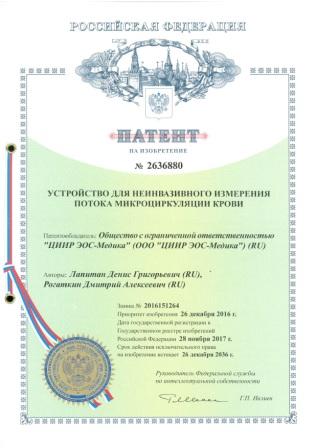
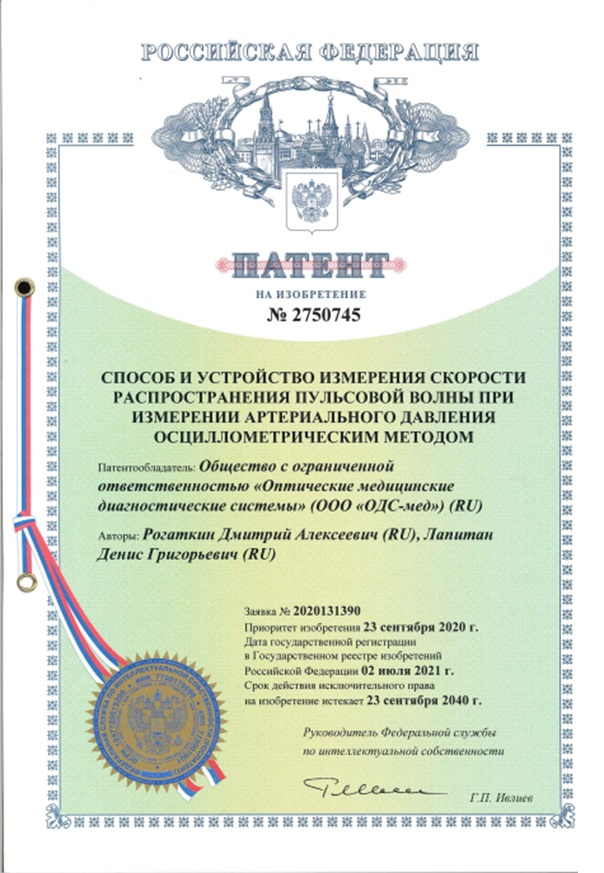
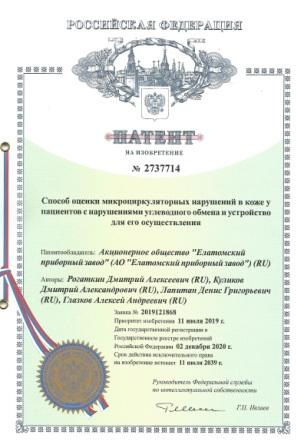
Main areas of application in medicine:
- Endocrinology: assessment of the severity of vascular lesions of the extremities at diabetes mellitus;
- Angiology: objectification of blood microcirculation in the skin of the extremities, assessment of the work of shunts and capillaries;
- Cardiology: assessment of the basic vascular tone and reactivity of the blood microcirculation system in the skin of the extremities in arterial hypertension;
- Vascular surgery: assessment of the hemodynamic significance of stenosis of the arteries of the extremities and the presence of critical ischemia of the extremities.


